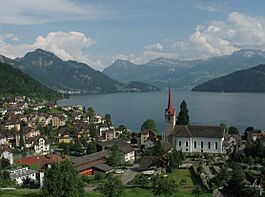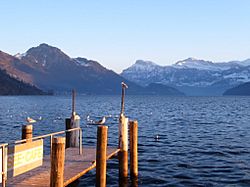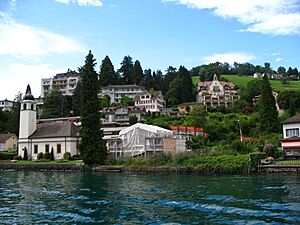Weggis facts for kids
Quick facts for kids
Weggis
|
||
|---|---|---|
 |
||
|
||
| Country | Switzerland | |
| Canton | Lucerne | |
| District | Lucerne | |
| Area | ||
| • Total | 11.79 km2 (4.55 sq mi) | |
| Elevation | 435 m (1,427 ft) | |
| Population
(Dec 2020 )
|
||
| • Total | 4,440 | |
| • Density | 376.6/km2 (975.4/sq mi) | |
| Postal code |
6353
|
|
| Localities | Unterdorf, Oberdorf, Hinterdorf, Rain, Laugneri, Baumen, Dörfli, Tischital, Rigiblick, Hertenstein, Riedsort, Bannholz, Bodenberg, Sentiberg, Rigi Kaltbad | |
| Surrounded by | Arth (SZ), Ennetbürgen (NW), Greppen, Küssnacht (SZ), Meggen, Stansstad (NW), Vitznau | |
Weggis is a lovely town, or municipality, located in the Canton of Lucerne in Switzerland. It sits right on the northern shore of Lake Lucerne. The main language spoken here is German.
Contents
History of Weggis
Around the year 800, a place called Wattawis was owned by a monastery. The name Weggis comes from an old Celtic word meaning "Place of the Ferrymen." This suggests people lived here even earlier.
The people of Weggis were very independent. Sometimes, they were under the rule of the Habsburgs, a powerful family. Local lords from Hertenstein managed things for both the monks and the Habsburgs.
By 1332, Weggis and a nearby town called Gersau became free areas. They even formed an alliance with the Old Swiss Confederacy, which was a group of independent states. This alliance was made official in 1359.
Later, in 1380, the Hertenstein lords sold their rights to Lucerne. Lucerne then governed Weggis until 1798. The people of Weggis often rebelled against Lucerne's rule before 1588. However, during the peasant war of 1653, they actually supported Lucerne.
In 1798, the community of Vitznau became its own separate town. In 2005, there was a plan to join three towns around Mount Rigi, but this idea was put on hold.
Geography and Climate of Weggis
Weggis is located on a piece of land that sticks out into Lake Lucerne. This area is at the bottom of a mountain called Rigi. This part of the lake is even named "Weggiserbuchts" after the town.
The town is famous for its very mild climate. This means it's often warm enough for many southern plants to grow here. You can see chestnut trees, palm trees, grapes, and even orchids thriving in Weggis.
Weggis sits on a flat area facing south, right by Lake Lucerne. It used to have just two main parts: Unterdorf (in the west) and Oberdorf (in the east). Over the years, new areas have grown, like Hinterdorf, Rain, Laugneri, Baumen, Dörfli, Tischital, and Rigiblick.
A community called Hertenstein is located southwest of the town, on a small peninsula by the lake. Near the border with Vitznau, other small groups of homes have grown together. These include Riedsort by the lake, and Bannholz, Bodenberg, and Sentiberg higher up the slope.
High up on the mountain, you can find Rigi Kaltbad. You can reach it by a special train called a cog railway or by an aerial tramway (a cable car). Many other small neighborhoods and farms are also part of Weggis.
Most of the western and central parts of Weggis are open land, not covered by forests. However, the slopes of Mount Rigi to the east are very different. This area is heavily forested. Big forests include the Kirchenwald and the Seeboden area.
The border of Weggis goes from Lake Lucerne up to Rigi-First, which is in another canton. Then it goes northwest to Rotstock mountain. After that, it turns west and goes south of Greppen back to Lake Lucerne.
Weggis covers an area of about 11.8 square kilometers (4.5 square miles). Almost half of this land (46.1%) is used for farming. About 38.9% is covered by forests. The rest of the land (14%) has buildings or roads, and a small part (1.1%) is non-productive, like rivers or mountains.
Neighboring Towns
Weggis shares its borders with Küssnacht and Greppen to the north. To the northeast, it borders Arth in Canton Schwyz. To the east and southeast, it borders Vitznau. And, of course, it is next to Lake Lucerne.
Population in Weggis
How the Population Has Grown
From 1850 to 1880, the number of people living in Weggis stayed mostly the same. But from 1880 to 1970, the population almost doubled! There were a couple of times when it didn't grow much, but overall, it increased by 94.5%.
In the 1970s, the population dropped a little (by 6%). But since then, it has grown a lot. This is because Weggis is a great place to live. Also, a local hotel management school attracts many students. Over 200 Chinese students, mostly from Shanghai, live in Weggis because of this school.
As of 2022, Weggis has a population of 4,440 people. In 2007, about 18.4% of the people living here were from other countries. Over the past 10 years, the population has grown by 13%.
| Population Growth | |
|---|---|
| Year | Population |
| 1850 | 1'279 |
| 1870 | 1'384 |
| 1880 | 1'294 |
| 1900 | 1'522 |
| 1950 | 2'247 |
| 1970 | 2'517 |
| 1980 | 2'367 |
| 1990 | 2'997 |
| 2000 | 3'616 |
| 2004 | 3'927 |
Languages Spoken
Most people in Weggis speak a dialect of Alemannic (or Swiss) German every day. The dialect here is quite different from the one spoken in Lucerne. It is more like the dialect used in Canton Schwyz.
- Here's an example:
- German: ich gehe (I go)
- Lucerne: ech goh
- Schwyz/Weggis: ich gah
- Another example:
- German: neu (new)
- Lucerne: nöi
- Schwyz/Weggis: nüü
In 2000, about 84.9% of people said German was their main language. About 1.63% spoke Portuguese, and 1.41% spoke English. However, the second most common language is Chinese. In the census, it was listed as an "East Asian Language."
Religious Groups
In the past, almost everyone in Weggis belonged to the Roman Catholic Church. But this has changed over time. People have moved away from the church, and new people have moved to Weggis from other parts of Switzerland and other countries.
As of 2000, about 59.98% of the people were Roman Catholic. About 16.7% were Protestant, and 1.66% were Eastern Orthodox Christians. About 10.01% said they didn't have a religion. A small group (1.99%) were Muslim. The rest (8.96%) didn't share their beliefs.
Many of the people who didn't share their beliefs might be Buddhist Chinese. The Chinese also make up most of the group who said they didn't have a religion. The Eastern Orthodox Christians and Muslims are mostly people from countries that used to be part of Yugoslavia.
Where People Come From
At the end of 2004, Weggis had 3,927 residents. Of these, 3,141 were Swiss citizens, and 786 (about 20%) were from other countries. In the last census, about 75.19% of residents were Swiss citizens. If you include people with dual citizenship, this number goes up to 80.31%.
The largest groups of people who have moved to Weggis come from China, Germany, Serbia and Montenegro (mostly Albania), Portugal, Italy, Austria, and the United Kingdom.
Life in Weggis
Political Choices
In the 2007 election, the most popular political party was the SVP. They received 32.8% of the votes. The next most popular parties were the CVP (24.9%), the FDP (23.9%), and the Green Party (8.2%).
Age Groups
In Weggis, about 17.9% of the people are 0–19 years old. About 22.7% are 20–39 years old. The largest group, about 37.5%, are 40–64 years old. For older residents, about 16.3% are 65–79 years old. About 4.8% are 80–89 years old, and 0.9% are 90 years or older.
Education and Jobs
About 72.8% of adults in Weggis (aged 25–64) have finished either high school or gone on to higher education, like university.
In 2000, there were 1,412 homes in Weggis. About 32.4% of these homes had only one person living in them. About 6.4% were large homes with five or more people. Most homes were two or three stories tall.
Weggis has a low unemployment rate of 1.9%. This means most people who want to work can find a job. In 2005, about 153 people worked in farming and related jobs. About 281 people worked in manufacturing and construction. The largest number of people, 1,209, worked in the service industry, which includes things like hotels, shops, and schools. In 2000, about 51.4% of the people in Weggis had a job. Women made up 45.8% of the working population.
Tourism in Weggis

After Lucerne city, Weggis is the second most popular place for tourists in Canton Lucerne. You can take an aerial tramway (a cable car) up to Rigi-Kaltbad. From there, you can see a viewpoint called Känzeli. You can also continue up the mountain on a special cog railway.
Weggis is sometimes called the "Riviera of Central Switzerland." This is because of its warm, almost "tropical" climate, which helps many unique plants grow.
Getting Around Weggis
Weggis is easy to reach by public transport, even though it doesn't have a train station. You can get there by boats and buses run by the Lake Lucerne Navigation Company. The "Riviera" bus line connects Weggis to nearby towns and train stations. For example, you can take a bus to Küssnacht or Brunnen, where there are train stations. Boats from Lucerne usually run every hour.
Weggis is also on a road that connects Küssnacht and Brunnen. The closest highway exit, for the A4, is about 10 kilometers (6 miles) away in Küssnacht.
Famous People from Weggis
- The French pianist Hélène Grimaud lives in Weggis.
- In 1932, the Russian composer Sergei Rachmaninoff bought land near Weggis in Hertenstein. He built a house there called Villa Senar, named after himself and his wife. He lived there until 1939, when World War II started. While living in his villa, Rachmaninoff finished two important musical works: his Rhapsody on a Theme of Paganini in 1934 and his Symphony No. 3 in 1936.
See also
 In Spanish: Weggis para niños
In Spanish: Weggis para niños








